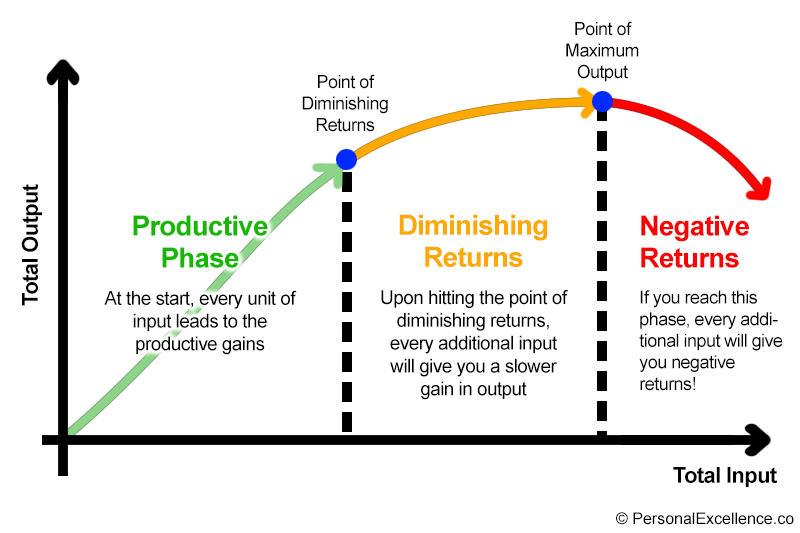Law of Deminishing Returns
What is it?
The Law of Diminishing Returns, also known as the Law of Diminishing Marginal Returns, states that as one input variable (such as labor or capital) is increased while all other inputs remain constant, there is a point at which the marginal or incremental output decreases or diminishes. In other words, there is a limit to the productivity of additional inputs, and after that point, the added input will result in a proportionally smaller increase in output.
The Law of Diminishing Returns is a principle in economics that explains how adding more of one thing to a process can, at some point, result in less effective or even counterproductive outcomes.
 PersonalExcellence.co
PersonalExcellence.co
Imagine you're baking cookies. You have a fixed amount of cookie dough and a certain number of cookie sheets. To make more cookies, you can add more workers to the process. Initially, adding more workers will help you make cookies faster because each worker can focus on a specific task, like mixing ingredients, rolling the dough, or putting cookies on the tray.
However, as you continue to add more workers, you'll eventually reach a point where adding more people doesn't help you make cookies any faster. This is because the kitchen space, cookie dough, and cookie sheets are limited. When too many workers are trying to use the same resources, they start getting in each other's way, and the process becomes less efficient.
In this example, the Law of Diminishing Returns tells us that there's an optimal number of workers to make cookies most efficiently. Beyond that number, adding more workers won't result in a proportional increase in output and may even slow down the process.
So, the Law of Diminishing Returns is a simple concept that helps us understand that more isn't always better, and that there's often a sweet spot where the best results can be achieved.
The Law of Diminishing Returns, also known as the law of diminishing marginal returns, is an economic principle that highlights the decreasing marginal output of a production process as a single variable input is increased, while other inputs remain constant. This concept has its roots in the works of classical economists such as David Ricardo, Robert Malthus, and Adam Smith, and can be related to various principles and scientific topics across different domains.
In essence, the Law of Diminishing Returns states that beyond a certain point, the addition of one more unit of a variable input (e.g., labor or capital) to a production process will result in a smaller increase in output than the previous unit. This occurs because the fixed inputs (e.g., land or machinery) become increasingly scarce relative to the variable input, leading to inefficiencies and decreasing productivity.
Relationship to Production Functions: The Law of Diminishing Returns can be illustrated using a production function, which is a mathematical representation of the relationship between inputs and output. The most common form of the production function is the Cobb-Douglas function, which exhibits diminishing returns due to the presence of exponents less than one for the variable inputs.
Connection to the Law of Supply: The Law of Diminishing Returns plays a crucial role in understanding the upward-sloping supply curve in microeconomics. As the marginal cost of production increases with higher levels of output, firms are less willing to supply additional units at the same price, leading to an upward-sloping supply curve.
Relevance to the Tragedy of the Commons: In environmental science and resource management, the Law of Diminishing Returns is relevant to the tragedy of the commons, a concept introduced by Garrett Hardin. When individuals overexploit a common resource, the marginal benefit of additional resource extraction decreases, leading to depletion and eventual collapse of the resource.
Application in Biology: The Law of Diminishing Returns can be applied to biological systems, such as population growth. The carrying capacity of an ecosystem represents the point at which the addition of more individuals leads to diminishing returns in terms of overall population growth, as resources such as food and shelter become increasingly scarce.
In conclusion, the Law of Diminishing Returns is a fundamental concept in economics that has applications and connections to various scientific fields. Its importance lies in understanding the limitations of growth and the trade-offs that arise from the allocation of scarce resources.
References
- Ricardo, D. (1817). Principles of Political Economy and Taxation. London: John Murray.
- Malthus, T. R. (1798). An Essay on the Principle of Population. London: J. Johnson.
- Smith, A. (1776). An Inquiry into the Nature and Causes of the Wealth of Nations. London: W. Strahan and T. Cadell.
- Cobb, C. W., & Douglas, P. H. (1928). A Theory of Production. The American Economic Review, 18(1), 139-165.
- Hardin, G. (1968). The Tragedy of the Commons. Science, 162(3859), 1243-1248.